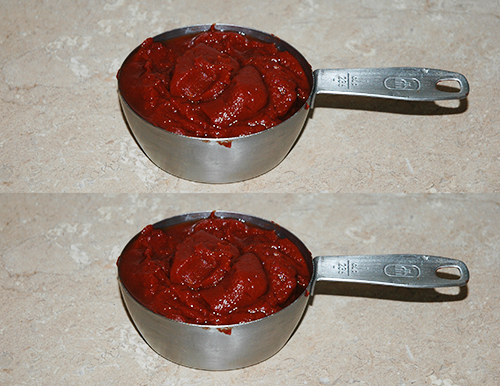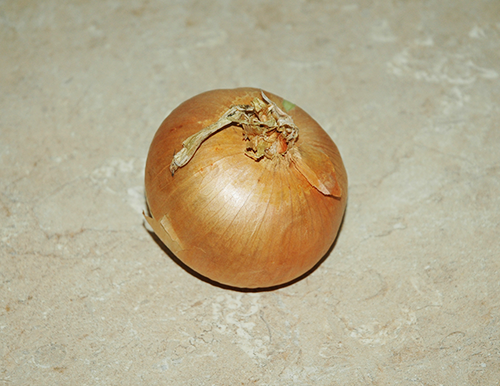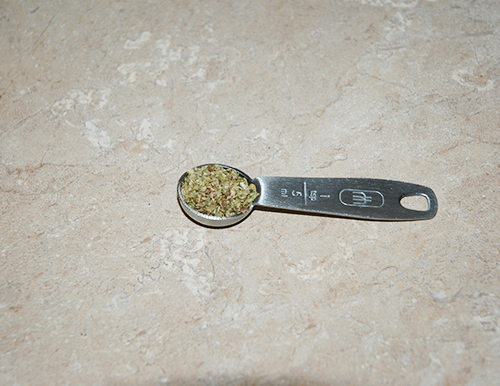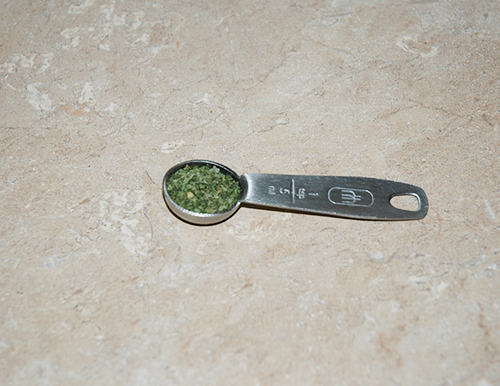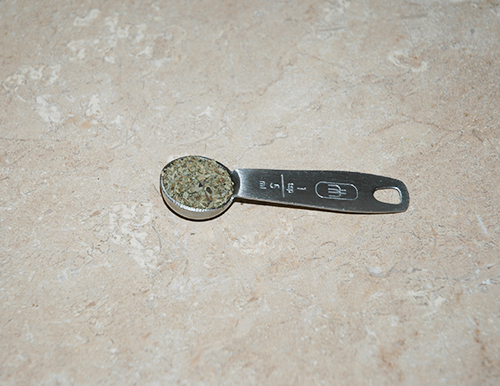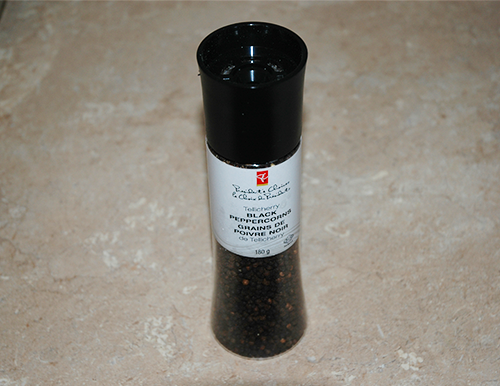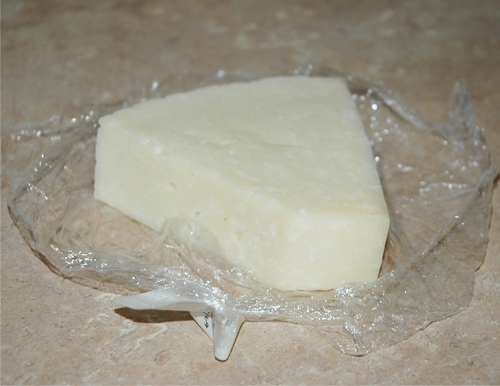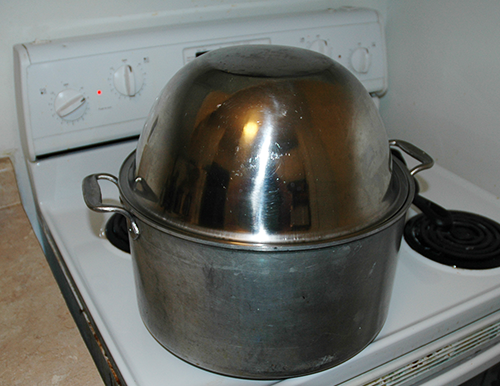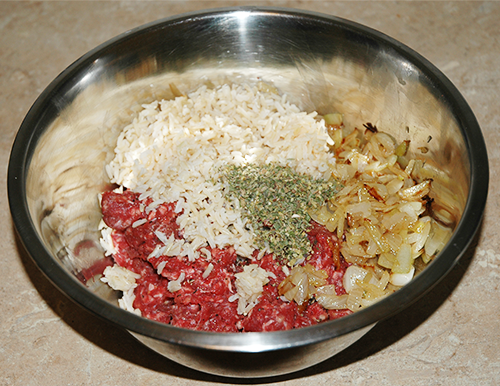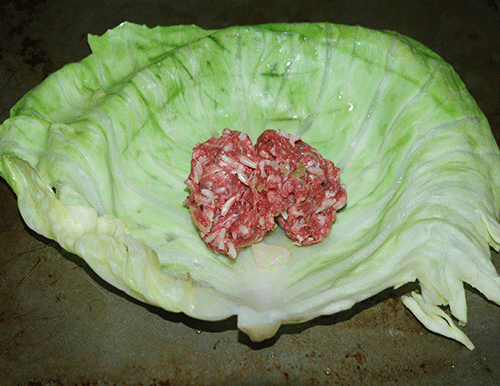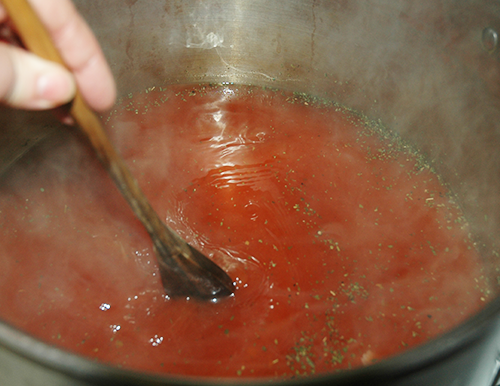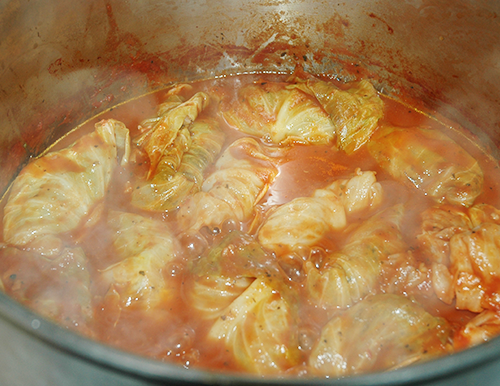Jump to Ingredients – Jump to Method – Jump to Printable Version
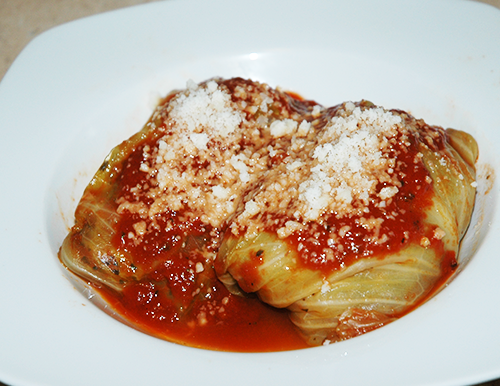
Does a halupkie by any other name taste as sweet? Absolutely! It seems like everyone has a different name for this dish. Some others include golabki, golumpkies, holubtsi, golubtsy, pigs in a blanket, or simply cabbage rolls. It seems to have originated as a Polish dish but most European countries have their own version, which is why there are so many different names for them, and the terms “pigs in a blanket” and “cabbage rolls” are some common American names for the dish. Whatever you call them, the basic idea is the same. Though there are many recipes with many variations, the basic idea is for minced meat mixed with rice and seasonings to be wrapped in cabbage leaves and cooked in a thin tomato sauce. Some people simmer them, some bake them, there really is no one right way. It is a very simple dish and it is really hard to go wrong when making them. I love them because they are so easy and quick to make, they look impressive, they are totally scrumptious, and they are really healthy! Trust me, if you were having intestinal problems, all that cabbage is going to scrub your system clean!
This recipe will yield about 12 halupkies. Two halupkies is a full meal, so you will get about 6 meals out of this recipe.
-Ingredients-
Cabbage
A large head of cabbage is best, but don’t worry if it is a little smaller. As long as the leaves are big enough to wrap the filling in them, it is ok. Keep in mind the size of your halupkies is totally up to you. This recipe assumes that you will be putting a quarter of a cup worth of meat filling into each cabbage leaf. If your cabbage is on the small side you can definitely put less filling into each one and just make mini halupkies.
Plain ordinary flat-leaf cabbage is the most common cabbage used for halupkies, but I have tried making them with savoy cabbage and it works well. It is a little different though. I will post about that experience another time. So, use flat-leaf cabbage if you just want to keep things simple and classic, but savoy cabbage is not out of the question.
1 pound Lean Ground Meat
Most people use beef. Some use pork. I use bison. Other meats are also acceptable. Whatever you like best! Just make sure that it is very lean for this recipe. Bison is one of the leanest meats there is, but it still has loads of flavour; one of the reasons I love it so much.
1 cup cooked Rice
Classically, white rice is used, but as usual, I opt for brown rice. Seriously, there is basically no difference in flavour or texture whether you use brown or white rice in this recipe. Why not go for more fiber and nutrients? Today I am using some gorgeous aromatic brown basmati rice.
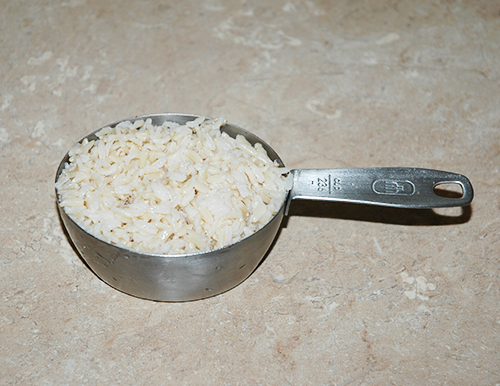 2 cups Tomato Paste
2 cups Tomato Paste
This is my own tomato paste. It has a glorious flavour. If you use tomato paste in this recipe, be sure to find one that tastes nice, since many kinds of tomato pastes from a can are bitter. If you can’t find one that tastes good, and you do not want to make your own, you can use an unseasoned tomato sauce (about 4 cups worth). You will just have to simmer it down for extra time to get the sauce the right consistency. (and really if you just want to use a seasoned tomato sauce and skip the seasonings I call for in this recipe go for it. Some people use tomato soup for crying out loud! Cooking isn’t rocket science just do what works for you!)
This one is a bit smaller than a baseball.
The herbs I use are great for this recipe, but you can experiment. There are lots of herb combinations that will taste wonderful!
Obviously I am using dried powdered herbs. You can definitely use fresh herbs if you wish.
These herb measurements work, but by all means, use more or less to taste!
To taste.
To taste.
 1 and 1/2 quarts (6 cups) Water
1 and 1/2 quarts (6 cups) Water
This is just a rough amount. The exact amount of water you use will vary depending on what kind of tomato products you actually use to make the sauce, the size and shape of your stock pot, and how you simmer the water, whether or not you put a lid on the simmering pot, etc. This is a good amount to start with, but through experimentation you may find a different amount works better for you. For the purposes of this recipe, I will assume that you are using tomato paste as I called for, and I will assume that you are using a large stock pot.
Pecorino Romano Cheese
This is totally optional, but I would not be satisfied with my halupkies without some cheese over top! Parmigiano-Reggiano cheese is a good substitute.
Also you will need some kind of fat to saute the onions. Butter, some kind of oil, or animal fat will work. Whatever you want to use.
-Method-
First dice your onion and saute until lightly browned and a little translucent. You don’t have to cook them to death. Set aside to cool.
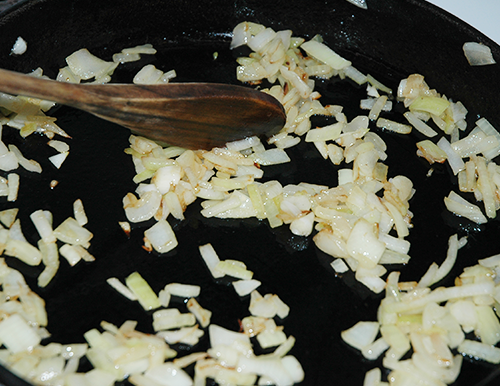 Pour 6 cups of water into a large stock pot and set on a hot burner to bring it up to a simmer.
Pour 6 cups of water into a large stock pot and set on a hot burner to bring it up to a simmer.
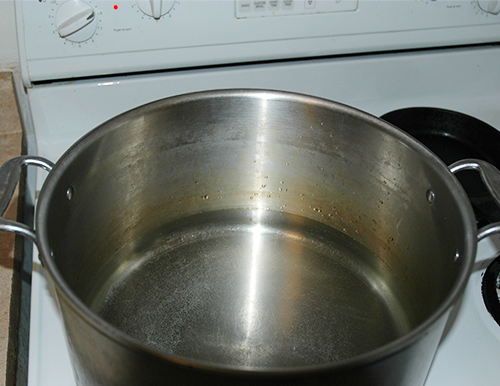 While the water is warming, wash your cabbage if needed and then cut around the stem while angling the knife towards the center of the head to remove the core of the cabbage. This will allow you to peel the leaves off of the head easily.
While the water is warming, wash your cabbage if needed and then cut around the stem while angling the knife towards the center of the head to remove the core of the cabbage. This will allow you to peel the leaves off of the head easily.
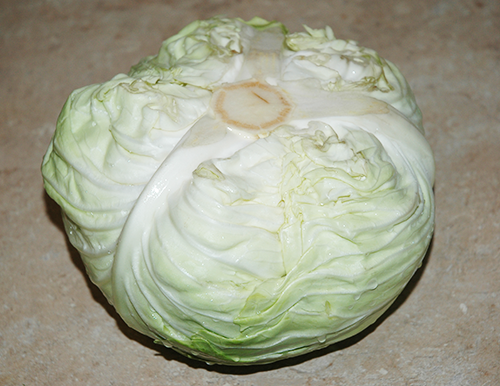
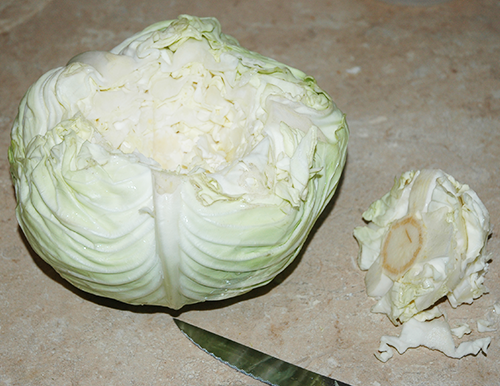 Once the water begins to simmer place the head, removed stem-side down, into the water. It will not be completely submerged. You are not going to boil the cabbage, rather you are going to steam it.
Once the water begins to simmer place the head, removed stem-side down, into the water. It will not be completely submerged. You are not going to boil the cabbage, rather you are going to steam it.
 Put a lid onto the pot and let the cabbage steam for about 3 to 4 minutes. Meanwhile, You can prepare the meat filling.
Put a lid onto the pot and let the cabbage steam for about 3 to 4 minutes. Meanwhile, You can prepare the meat filling.
I do not have a lid for this pot, so I had to improvise and use a large stainless steel bowl to cap it. It looked ridiculous but it worked!
The meat mixture and the sauce are both going to share the herbs. To make it easy just put a teaspoon each of basil, oregano, and thyme into a small cup or ramekin and mix them together.
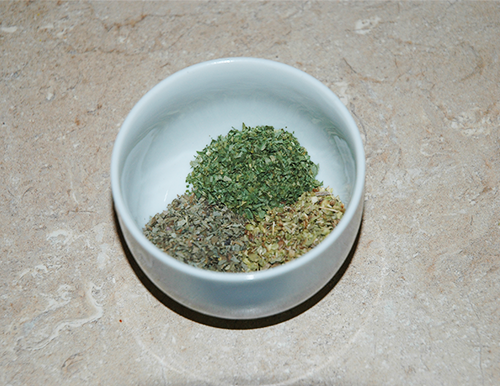
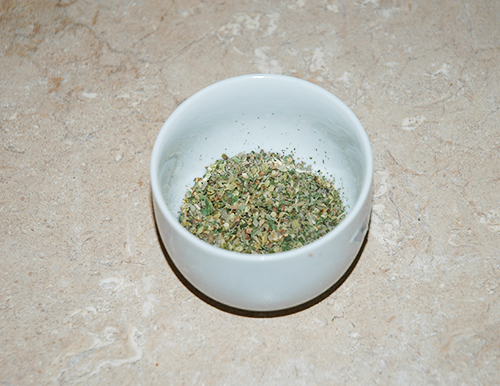 To prepare the meat mixture first make sure that the onions are cooled to be at least only luke warm or cooler. Add to the pound of ground meat, all of the onions, a cup of cooked rice, roughly two thirds of the mixed herbs (the last third is for the sauce), and a generous amount of salt and pepper. Mix it all together well. I recommend cooking about a teaspoon sized amount of meat filling quickly either in a pan or in the microwave (30-40 seconds) and tasting it for seasoning. You don’t want a bland filling! So get enough salt and pepper in there!
To prepare the meat mixture first make sure that the onions are cooled to be at least only luke warm or cooler. Add to the pound of ground meat, all of the onions, a cup of cooked rice, roughly two thirds of the mixed herbs (the last third is for the sauce), and a generous amount of salt and pepper. Mix it all together well. I recommend cooking about a teaspoon sized amount of meat filling quickly either in a pan or in the microwave (30-40 seconds) and tasting it for seasoning. You don’t want a bland filling! So get enough salt and pepper in there!
Now is a good time to check on the cabbage. You will notice that the top leaves are softened and they may be curling a bit. This is exactly what you want.
 Using tongs, or your fingers if you can take the heat, pull off the first few cabbage leaves, taking care not to rip them. At this point you will probably be able to easily remove two to four leaves. They should pull right off with little to no trouble. Place the removed leaves onto a plate. Do not force any leaves to come off. Once you get to one that doesn’t seem ready to come off, simply cap the pot again and wait 2 to 3 more minutes.
Using tongs, or your fingers if you can take the heat, pull off the first few cabbage leaves, taking care not to rip them. At this point you will probably be able to easily remove two to four leaves. They should pull right off with little to no trouble. Place the removed leaves onto a plate. Do not force any leaves to come off. Once you get to one that doesn’t seem ready to come off, simply cap the pot again and wait 2 to 3 more minutes.
 Every two to three minutes you should be able to remove about two to three leaves. Continue until you have removed at least 12 leaves. You may want to pull a couple extra in case there is some unforeseen disaster that happens to some of them. You now have a plate that is piled high with softened cabbage leaves.
Every two to three minutes you should be able to remove about two to three leaves. Continue until you have removed at least 12 leaves. You may want to pull a couple extra in case there is some unforeseen disaster that happens to some of them. You now have a plate that is piled high with softened cabbage leaves.
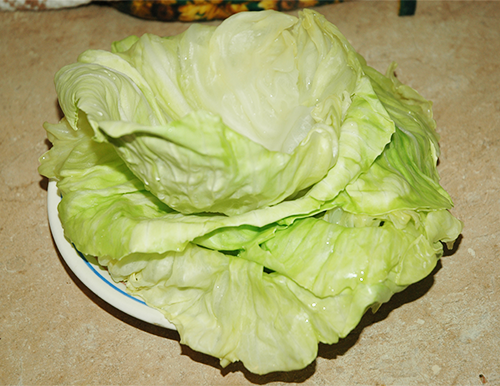 You also have a partial head of cabbage left. What I typically do with this is cut it into four wedges and cook them right along with the halupkies. A plate of steamed cabbage with the halupkie sauce and cheese is a delectable and healthy meal all on its own. You can choose not to do this, but I want you to be aware that this is an option.
You also have a partial head of cabbage left. What I typically do with this is cut it into four wedges and cook them right along with the halupkies. A plate of steamed cabbage with the halupkie sauce and cheese is a delectable and healthy meal all on its own. You can choose not to do this, but I want you to be aware that this is an option.
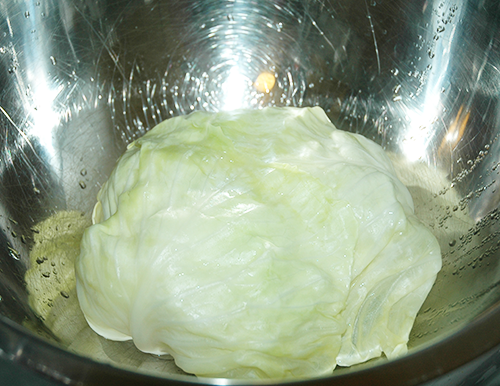 Now it is time to roll the halupkies. What I like to do is use a 1/4 cup dry measuring cup to scoop out just the right amount for each halupkie. This keeps them consistent and pretty much always works out perfectly to make 12 halupkies.
Now it is time to roll the halupkies. What I like to do is use a 1/4 cup dry measuring cup to scoop out just the right amount for each halupkie. This keeps them consistent and pretty much always works out perfectly to make 12 halupkies.
The cabbage leaves will be curled. Put the meat onto the concave side of the cabbage.
One way to fold the halupkies, as shown in the animation below, is to roll the cabbage leaf all the way up starting from the stem side. Then simply pull the sides into the middle and overlap them as much as you can. Fasten it with a toothpick.
Another way to fold them, as shown below, is to fold the stem side up over the meat, only to the center of the leaf. Fold the sides in, and overlap them as much as possible, then finish rolling it up to the top of the leaf. Secure the top flap with a toothpick. Either wrapping style works equally well.
 When you are finished wrapping all of the halupkies, add two cups of tomato paste and the remaining third of the herbs to the simmering cabbage water. Also add a little salt and pepper. Stir to combine all the ingredients well.
When you are finished wrapping all of the halupkies, add two cups of tomato paste and the remaining third of the herbs to the simmering cabbage water. Also add a little salt and pepper. Stir to combine all the ingredients well.
Place the halupkies into the simmering sauce.
 I am able to fit all of the halupkies on a single layer due to the size of my pot, but it is ok if you have to stack them. If the sauce comes up high enough in your pot to at least touch all of the halupkies then you are in good shape. If there is not enough liquid to touch all of them you can cap the pot during some of the cooking time to steam them, but you will have to uncap and simmer for longer than normal in order to simmer the sauce down. Exactly how you handle this part of the cooking depends on your situation, but do not fear, it is really hard to ruin these. You can simmer for as long as you want within reason, so if the sauce is still too thin after an hour, go ahead and simmer it for up to another hour if needed. You can boil them more rapidly if you wish to speed things up, but some of the halupkies might fall apart.
I am able to fit all of the halupkies on a single layer due to the size of my pot, but it is ok if you have to stack them. If the sauce comes up high enough in your pot to at least touch all of the halupkies then you are in good shape. If there is not enough liquid to touch all of them you can cap the pot during some of the cooking time to steam them, but you will have to uncap and simmer for longer than normal in order to simmer the sauce down. Exactly how you handle this part of the cooking depends on your situation, but do not fear, it is really hard to ruin these. You can simmer for as long as you want within reason, so if the sauce is still too thin after an hour, go ahead and simmer it for up to another hour if needed. You can boil them more rapidly if you wish to speed things up, but some of the halupkies might fall apart.
At this point in the cooking process the sauce is very thin. The goal from here is to simmer the sauce down and thicken it, as well as cook the meat inside the cabbage. The way I do it is to simmer for about an hour, uncovered, turning the halupkies two or three times during simmering. I keep the simmer fairly heavy, so that it is sort of in between a boil and a simmer. You could call it a low boil if you want.
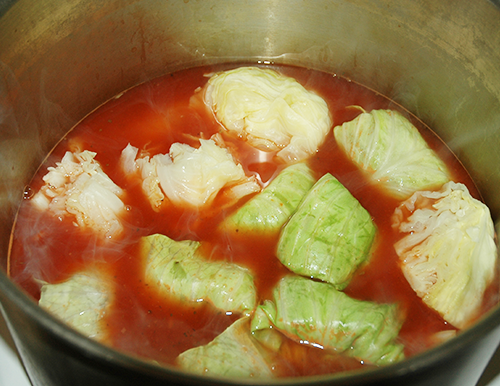 Here are my halupkies after they have been simmering in the sauce for about 30 minutes. I have turned them once. The meat is definitely fully cooked by now and the only thing left is to get the sauce to a good consistency. It is still too watery.
Here are my halupkies after they have been simmering in the sauce for about 30 minutes. I have turned them once. The meat is definitely fully cooked by now and the only thing left is to get the sauce to a good consistency. It is still too watery.
Here we are after another 30 minutes of uncovered steady simmering, and the sauce is perfect. It is not supposed to be a thick sauce like what you would put on pasta. It should be thin and soupy, but with just enough body that it lightly coats the halupkies. I have turned the halupkies a couple more times to enrobe them in sauce.
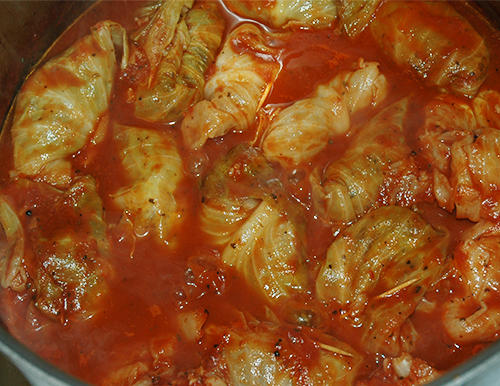 Now you can serve them. I think that two halupkies is a perfect full meal. You have greens, a bit of starch and meat. Everything you need for a satisfying meal. If you are extra hungry then three will definitely hit the spot. You can also serve just one as a main course along with bread (maybe garlic bread!)and/or a salad to make a meal. Whatever way you serve them, they are 10 times tastier if you dust them with Romano cheese!
Now you can serve them. I think that two halupkies is a perfect full meal. You have greens, a bit of starch and meat. Everything you need for a satisfying meal. If you are extra hungry then three will definitely hit the spot. You can also serve just one as a main course along with bread (maybe garlic bread!)and/or a salad to make a meal. Whatever way you serve them, they are 10 times tastier if you dust them with Romano cheese!
Oh and do not forget to remove the toothpicks, or if you leave them in, inform whoever is eating them that there are toothpicks in there.
 Halupkies freeze really well. I often make a big batch and freeze them in serving sizes to have for lunches and quick dinners over the next couple of weeks. You can easily microwave them from frozen, or bake them, or simmer them. Be sure to include some of the sauce with each serving if you are going to freeze them.
Halupkies freeze really well. I often make a big batch and freeze them in serving sizes to have for lunches and quick dinners over the next couple of weeks. You can easily microwave them from frozen, or bake them, or simmer them. Be sure to include some of the sauce with each serving if you are going to freeze them.
-Printable Version-
HALUPKIES
Ingredients:
1 head of Cabbage
1 pound Lean Ground Meat
1 cup cooked Rice
2 cups Tomato Paste
1 White or Yellow Onion
1 teaspoon Oregano
1 teaspoon Basil
1 teaspoon of Thyme
Black Pepper
Salt
1 and 1/2 quarts (6 cups) Water
OPTIONAL – Pecorino Romano Cheese
Method:
1. Dice your onion and saute until lightly browned and a little translucent. Set cooked onions aside to cool.
2. Pour 6 cups of water into a large stock pot and set on a hot burner to bring it up to a simmer.
3. While the water is warming, wash your cabbage if needed and then cut around the stem while angling the knife towards the center of the head to remove the core of the cabbage.
4. Once the water begins to simmer place the head, removed stem-side down, into the water. It will not be completely submerged. You are not going to boil the cabbage, rather you are going to steam it. Put a lid onto the pot and let the cabbage steam for about 3 to 4 minutes. Meanwhile, You can prepare the meat filling.
5. Put a teaspoon each of basil, oregano, and thyme into a small cup or ramekin and mix them together.
6. Add to the pound of ground meat, all of the onions, a cup of cooked rice, roughly two thirds of the mixed herbs (the last third is for the sauce), and a generous amount of salt and pepper. Mix it all together well.
7. When the outer cabbage leaves soften, pull them off and set them aside. Recap the pot and steam for two to three minutes at a time. You should be able to pull off two to three leaves for every two to three minutes of steaming.
8. Put 1/4 cup worth of meat into each cabbage leaf and roll them up, securing them closed with a toothpick.
9. Add to the cabbage water two cups of tomato paste and the remaining third of the herb mixture, along with some salt and pepper to taste and mix everything until well combined. Keep the sauce at a steady simmer or a low boil.
10. Place the halupkies into the simmering sauce.
11. Allow the halupkies to cook in the steadily simmering sauce, uncovered, (though you may cover the pot for about half the cooking time if you want to steam the halupkies) for about an hour, or until the sauce is thick enough to lightly coat the halupkies (If for some reason the sauce is thick before an hour is up just add a little water to thin it). Turn the halupkies a couple times during simmering to coat them well and to allow all sides of them to cook evenly.
12. When plating the halupkies, remove the toothpicks. Serve with grated Romano cheese sprinkled on top.



